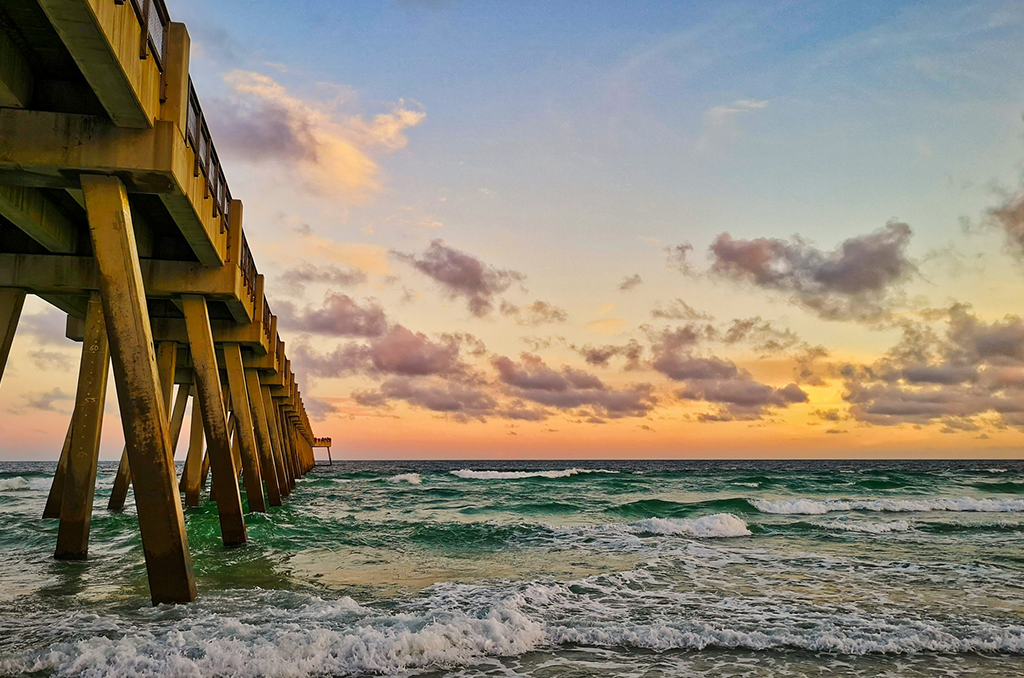Beach & pier in Florida — Courtesy: Image by McRonny from Pixabay
Egmont Key reopened in April 2025 following significant hurricane damage in 2024. A few buildings close to the lighthouse area are still off-limits to the general public.
Egmont Key, an island in the mouth of Tampa Bay, has always captivated me because I always thought it would be a spot away from the throng, secluded, untamed, and natural.
Although it wasn’t what we had anticipated, we had a great day on Egmont Key.
It’s not vacant because it’s a well-liked site for visitors arriving by private boat and ferry. Despite its beauty, the beach is far from deserted and isn’t much better than the beaches of Pass-a-Grille to the north or Anna Maria Island to the south.
But what’s unique is the fascinating history you encounter here. Egmont Key is a fantastic trip if, like me, you enjoy touring abandoned forts or ghost villages in the middle of a forest.
In addition to being cooperatively maintained with the state, which runs Egmont Key State Park here, Egmont Key is protected as Egmont Key National Wildlife Refuge.
Even though there are many people on the island, Egmont Key is a secluded location, so be ready. It lacks restrooms, drinking water, and automobiles. You can’t camp overnight, and you have to come by boat.
This is not a cheap excursion, as ferry tickets range from $40 to $70, depending on the option you select.
Why would you go, and is it worth it?
Here are five aspects of Egmont Key that I adored:
Investigating the romantically ruined Fort Dade.
strolling down the lovely red brick roads of the fort, which are now lanes through a bush.
Seeing a lot of gopher tortoises. They are omnipresent, and they don’t back down when you encounter them on the brick roadways.
Having a meal on the beach while watching the Gulf of Mexico swallow up the remains of Fort Dade’s power plant.
observing the little historic cemeteries beside the charming lighthouse, where lighthouse keepers and their family are buried on one side and Civil War veterans on the other.
The tale of Fort Dade and Egmont Key
Egmont Key is roughly 1.6 miles long and 1.6 miles from Fort De Soto Park, which is located at the base of St. Pete Beach.
As part of the Egmont Key National Wildlife Refuge’s bird habitat, a large portion of the island’s southern half and bayside coastline are off-limits.
Twenty thousand of the 25,000 bird couples that nested on Egmont Key in 2020 were laughing gulls. American oystercatchers, brown pelicans, black skimmers, and sandwich and royal terns are among the other species.
Up until the middle of the nineteenth century, Egmont Key was mostly a bird sanctuary. The only human habitation was a lighthouse, which was occupied by the Union Army during the Civil War and by Seminole Indians who were interned here during the Third Seminole War.
However, Fort Dade was constructed on the island in 1898 in response to the threat of the Spanish-American War, and it remained operational until 1923. You are now free to roam throughout these Fort Dade remains.
Fort Dade had 300 people, red brick roads, telephones, electricity, a jail, a movie theater, a bowling alley, tennis courts, and a hospital at its height. All of it is now gone, save for the foundations and the remains of the strong fort batteries.
Egmont Key State Park: How to Get There
There are now two ways to get reach Egmont Key by ferry:
The original ferry from Fort DeSoto Park allows for a three-hour excursion and takes 20 minutes. Adult tickets cost $45; children ages 3 to 11 cost $25. Reservations and other details can be found here.
The new service is a ferry on a larger vessel with bathooms called the Pelican that departs from the St. Pete Pier. An hour-long boat cruise beneath the Sunshine Skyway and past the St. Petersburg skyline begins this excursion. It costs $59 for adults and $39 for children, and it departs at 9 a.m. and 1 p.m. and allows two hours on the island. For additional information on the Pelican tour to Egmont Key,
Expectations for a trip to Egmont Key
We had reserved the 11 a.m. ferry from Fort DeSoto to Egmont Key for the Friday after Thanksgiving. The company typically operates one ferry every day during this time of year. However, due to the holiday weekend, they had added a number of additional voyages, such as a ferry at 10 and 11:30 a.m.
The Fort DeSoto-Egmont Key ferry is two-thirds covered and partially open air. It takes roughly 20 minutes to get to the island. With a set time to board for your return, the ferry ticket permits a three-hour visit.
Other visitors arrive by power boat, anchoring off the beaches, in addition to those who arrive by ferry. This was not quite a desolate island, as there were perhaps 100 power boats on the day we were there.
You can start exploring in either direction after the 49-passenger ferry from Fort DeSoto docks on the bay side of the lighthouse. On the adjoining beach, some people quickly reserved spots. The walk beyond the ruins of Fort Dade was where we began.
All three of the original Fort Dade batteries are largely undamaged. (One, however, is plummeting into the Gulf.) The different shades of blue in Tampa Bay may be seen from the top of the stairs, which offer pleasant views across the sand dunes. You can wander around the battery’s cold, thick-walled compartments. Children were quite excited to explore this area.
Built below the ground, these enormous bunkers are imperceptible to an approaching ship, which would be swept by fire from their vanishing cannons. When a system enables the guns to retract into concrete pits after firing, they “disappear.” The introduction of the airplane rendered this lovely technique obsolete.
But the firearms are no longer there. Some have been relocated to the park where the ferry departs, Fort De Soto. (If you are interested in military history, you should go to Fort De Soto and Fort Dade on Egmont Key.)
Federal officials purposefully started the fire in 1925 in an attempt to smoke out rum runners and others, destroying the once-impressive edifice.
These days, you can walk and examine the three batteries that are beyond the walkways. As you continue walking, you reach the red brick streets that lead through the abandoned community that was built around the fort.
The detailed labeling that identifies each structure—from the morgue to the officers’ tennis court—is what really brings it to life.
Mosquitoes and gopher tortoises are currently the only inhabitants. The mosquitoes were ferocious around the end of November, but I’m not sure if they’re there all year. Bring insect repellent.
Advice for travelers visiting Egmont Key
You have two or three hours if you arrive by ferry, therefore you must prioritize your tasks. We didn’t have time to swim or search for shells or shark teeth, so we decided to have a picnic on the Gulf beach and take a stroll around the ancient fort area.
We had a great time at our picnic spot. About a mile from the ferry landing spot, on the Gulf side, were the power plant’s ruins, which are being engulfed by the rising water. We laid our beach blanket on the sand and took in the lovely view of the sea and ruins while finding shade from the trees that border the beach.
Near the ferry landing, there are picnic tables in a wooded grove.
With views of sailboats, the Sunshine Skyway Bridge, the lighthouse on Egmont Key, and the St. Petersburg skyline, the ferry boat voyage from Fort DeSoto is enjoyable even though it only takes around 20 minutes. (The vista on the lengthier journey from the pier must be breathtaking.)
On Egmont Key, you might have to walk into the surf to get off the boat, so wear shoes that can get wet.
Because it is a wildlife preserve, you are not allowed to bring dogs, alcohol, glass, kites, or drones to the island.
Egmont Key is a well-liked location for snorkeling from spring to October. When we visited in late November, the Gulf waters were a cold 68 degrees, and very few people went snorkeling. Snorkeling equipment is available for rent on the ferry from Fort DeSoto.
Is it possible to kayak to Egmont Key? Yes, seasoned paddlers who know the tides and currents and have the appropriate kayak in the correct weather do make the journey. But before you leave, make sure that describes you.
Stories that matter are our priority. At Florida Insider, we make sure that the information we provide our readers is accurate, easy-to-read, and informative. Whether you are interested in business, education, government, history, sports, real estate, nature or travel: we have something for everyone. Follow along for the best stories in the Sunshine State.
Chris began his writing as a hobby while attending Florida Southern College in Lakeland, Florida. Today he and his wife live in the Orlando area with their three children and dog.

